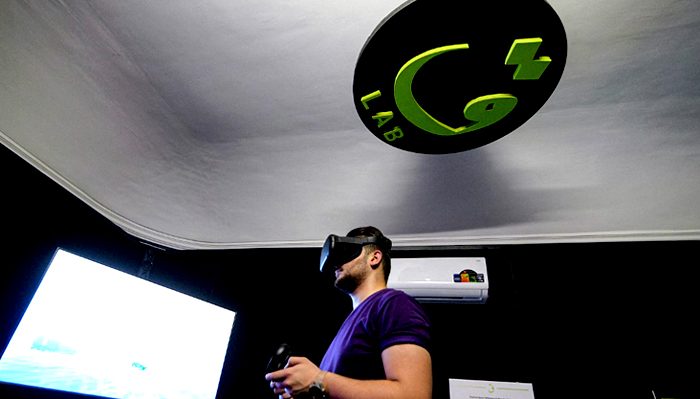The Old City of Mosul was reduced to rubble.
Related: Meta will sell virtual clothing for real money at an ad-hoc fashion boutique.
MOSUL, Iraq (AFP) –An Iraqi museum is reversing the passage of time by using computer technology and virtual reality goggles to allow visitors to tour cultural sites damaged by fighters and in fights to defeat them.
In a quick attack in 2014, terrorists from the Islamic State group took over a third of Iraq. They made Mosul their capital and damaged or destroyed a huge number of cultural landmarks across the country.
Using hundreds of pictures, a group of local engineers have almost brought back to life five historic sites in Mosul and the province of Nineveh around it. These include a mosque and its leaning minaret.
Mahiya Youssef said, “It takes you to another universe” as she took off the virtual reality (VR) goggles from her rose-covered headscarf at the Mosul Heritage House museum, where she had been looking at 3D photos of destroyed buildings.
Youssef, 50, who works at a food factory in the northern city, stated, “I truly wish it was the actual city of Mosul, not just a simulation.” The return to reality is excruciating.
Abu Bakr al-Baghdadi’s only known public appearance was in Mosul’s Al-Nuri mosque, where he announced the start of a “caliphate.”
Related: Following the “winter” of bitcoin, investors are looking for risk in virtual worlds.
During the war to recover the city, the Old City of Mosul was reduced to rubble, including the mosque and its neighbouring leaning minaret, known as Al-Hadba, or the “hunchback.”
IS is suspected by Iraqi officials of placing explosives at the location before their evacuation. Only the base of the minaret remained.
“Recover memories”
VR technology has previously been utilised to replicate the heritage destroyed by the IS organisation, notably in a US show backed by UNESCO.
However, this museum brings the landmarks to life for the residents of Mosul.
“Many youngsters have never seen the Al-Nuri mosque and its Al-Hadba minaret,” says the museum’s creator, 29-year-old Ayoub Younes.
“We try to use virtual reality to make people feel like they’ve been to these places and remember what they did there.”
Five years after Iraqi forces and an international coalition drove the insurgents out of Mosul in 2017, work is still going on to fix the city’s old buildings, mosques, and cathedrals.
Large portions of the Old City, however, remain covered in debris.
While some of the city’s inhabitants have returned to neighbouring neighbourhoods, the majority of the city remains a patchwork of destroyed or under-construction structures.
According to Younes, the private museum with a marble front near the Tigris river opened in mid-June and received over 4,000 visitors in its first month.
In a sombre chamber, eager museumgoers wait to use the museum’s lone virtual reality headset, a pair of huge black googles.
Related: How Netflix wants to find its “Star Wars” side.
The famous Al-Tahera church, which is in the once-winding streets of the Old City, and the almost 2,000-year-old Hatra archaeological site in the desert south of Mosul are also on the virtual tour.
The extremists used firearms and pickaxes to destroy the once-vast ruins of the ancient city, sharing video footage of their orgie of destruction in 2015.
“Preserving the memory”
Abdullah Bashir showed a 3D copy of the mosque where the Nabi Yunus shrine was in 2014. Both Muslims and Christians thought that the shrine was the grave of Prophet Jonah.
“We used personal photographs and photographs taken by locals” to rebuild the past status of the places, he explained.
However, he stated that there were “extremely few” images before 2014, noting the “lack of photographs” as the primary challenge.
Bashir and other experts from QAF Lab brought the past back to life in a project that he calls “preserving the legacy of Mosul.”
After Mohammed Abdullah finished his virtual tour, he rolled his wheelchair through the vaulted halls of the museum to look at the real exhibits.
Some of the artefacts came from local families. They include terracotta amphorae, oil lamps, traditional wall hangings, metal containers, and even an old radio.
Abdullah, a 28-year-old student of telecommunications engineering, stated that the difference between virtual reality and the reality of Mosul was excruciating.
Abdullah stated that “reconstruction is exceedingly sluggish and insufficient in comparison to the destruction.”
Related: Meta reduces recruitment plans in preparation for “ferocious” headwinds.
He pushed for historic places to be fixed quickly so that they could attract tourists and “revitalize” nearby communities.
He has not given up hope despite the nasty taste the virtual visit left in his mouth.
“The day will come when we will really make this trip,” he remarked. It will be superior to the simulated version.

